Change Management Models and Implementation at PepsiCo: A Report
VerifiedAdded on 2020/03/16
|23
|5956
|155
Report
AI Summary
This report provides an in-depth analysis of PepsiCo's change management strategies, focusing on the application of the Waterman 7s model and the Kurt Lewin change management model. The report begins with an executive summary and an introduction to PepsiCo, highlighting its global presence and mission. It then delves into the Waterman 7s framework, examining the company's strategy, structure, systems, shared values, skills, style, and staff. Following this, the report explores the Kurt Lewin change management model, outlining the unfreezing, change, and refreeze stages in the context of PepsiCo. Key factors demanding change, such as globalization, are discussed, along with resource implications, including human, technological, financial, and physical resources. The report also addresses employee resistance to change and suggests strategies for overcoming it, such as motivation and effective communication. Finally, the report offers recommendations and conclusions based on the analysis, providing insights into how PepsiCo can effectively implement change management initiatives.
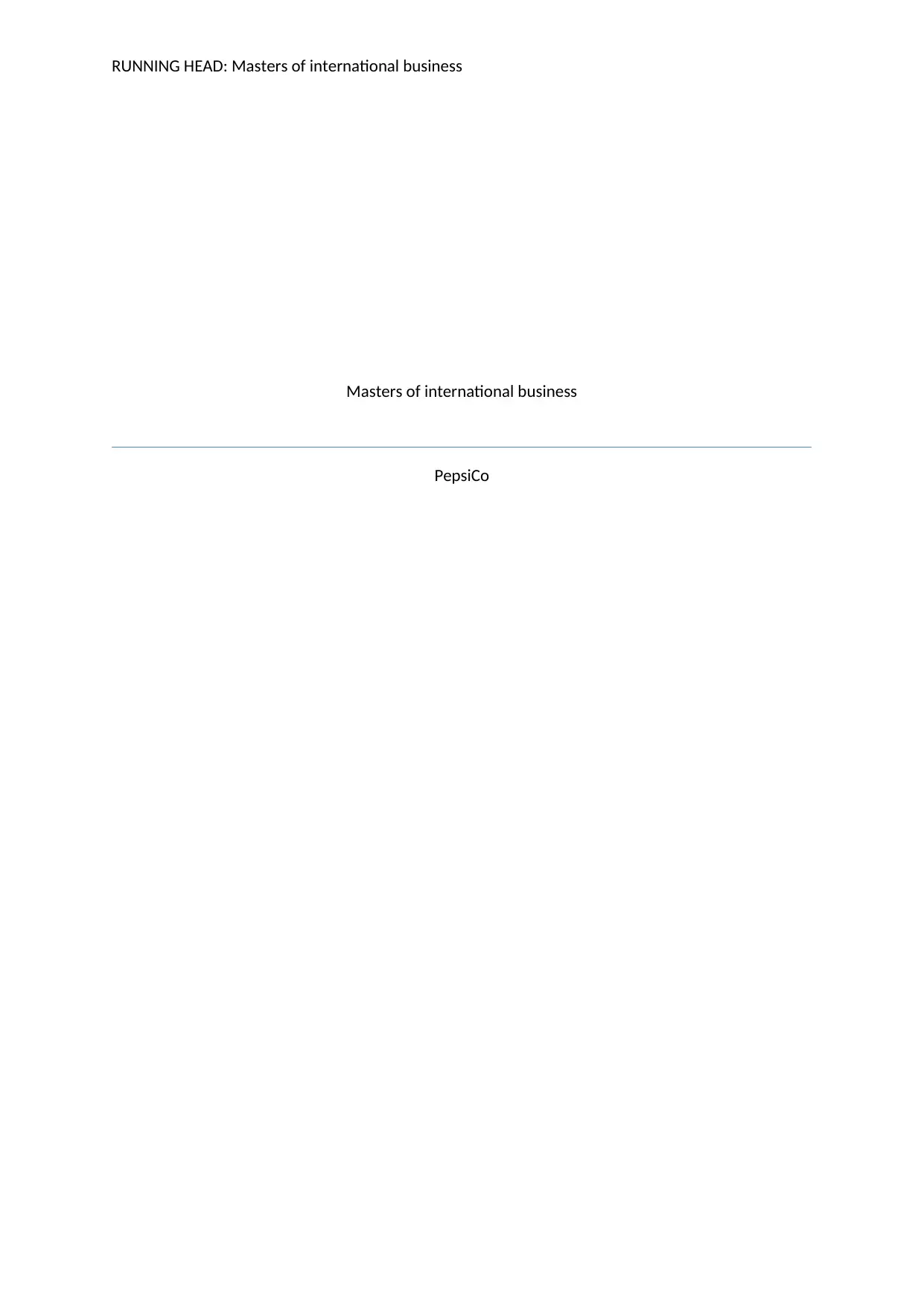
RUNNING HEAD: Masters of international business
Masters of international business
PepsiCo
Masters of international business
PepsiCo
Paraphrase This Document
Need a fresh take? Get an instant paraphrase of this document with our AI Paraphraser
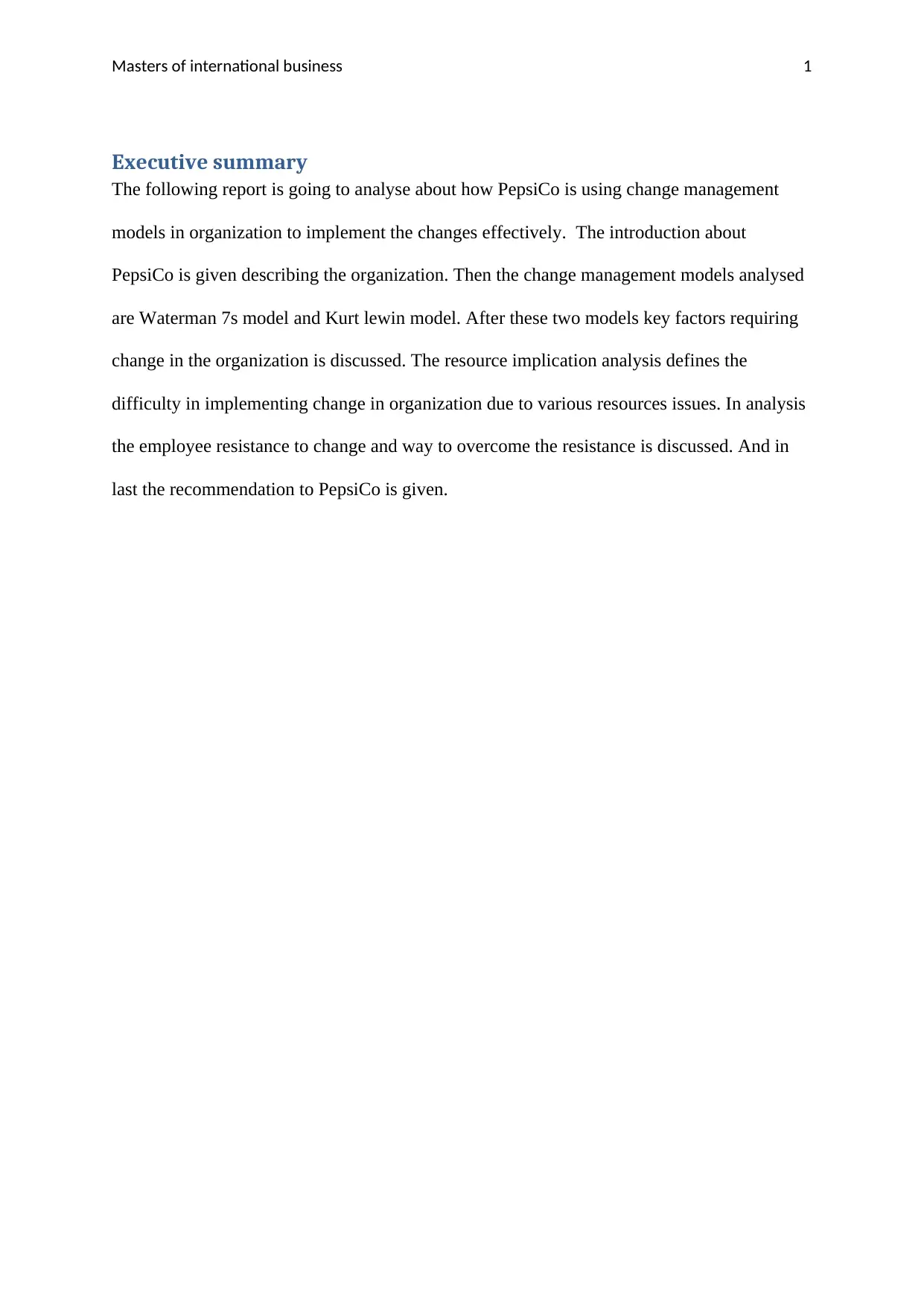
Masters of international business 1
Executive summary
The following report is going to analyse about how PepsiCo is using change management
models in organization to implement the changes effectively. The introduction about
PepsiCo is given describing the organization. Then the change management models analysed
are Waterman 7s model and Kurt lewin model. After these two models key factors requiring
change in the organization is discussed. The resource implication analysis defines the
difficulty in implementing change in organization due to various resources issues. In analysis
the employee resistance to change and way to overcome the resistance is discussed. And in
last the recommendation to PepsiCo is given.
Executive summary
The following report is going to analyse about how PepsiCo is using change management
models in organization to implement the changes effectively. The introduction about
PepsiCo is given describing the organization. Then the change management models analysed
are Waterman 7s model and Kurt lewin model. After these two models key factors requiring
change in the organization is discussed. The resource implication analysis defines the
difficulty in implementing change in organization due to various resources issues. In analysis
the employee resistance to change and way to overcome the resistance is discussed. And in
last the recommendation to PepsiCo is given.
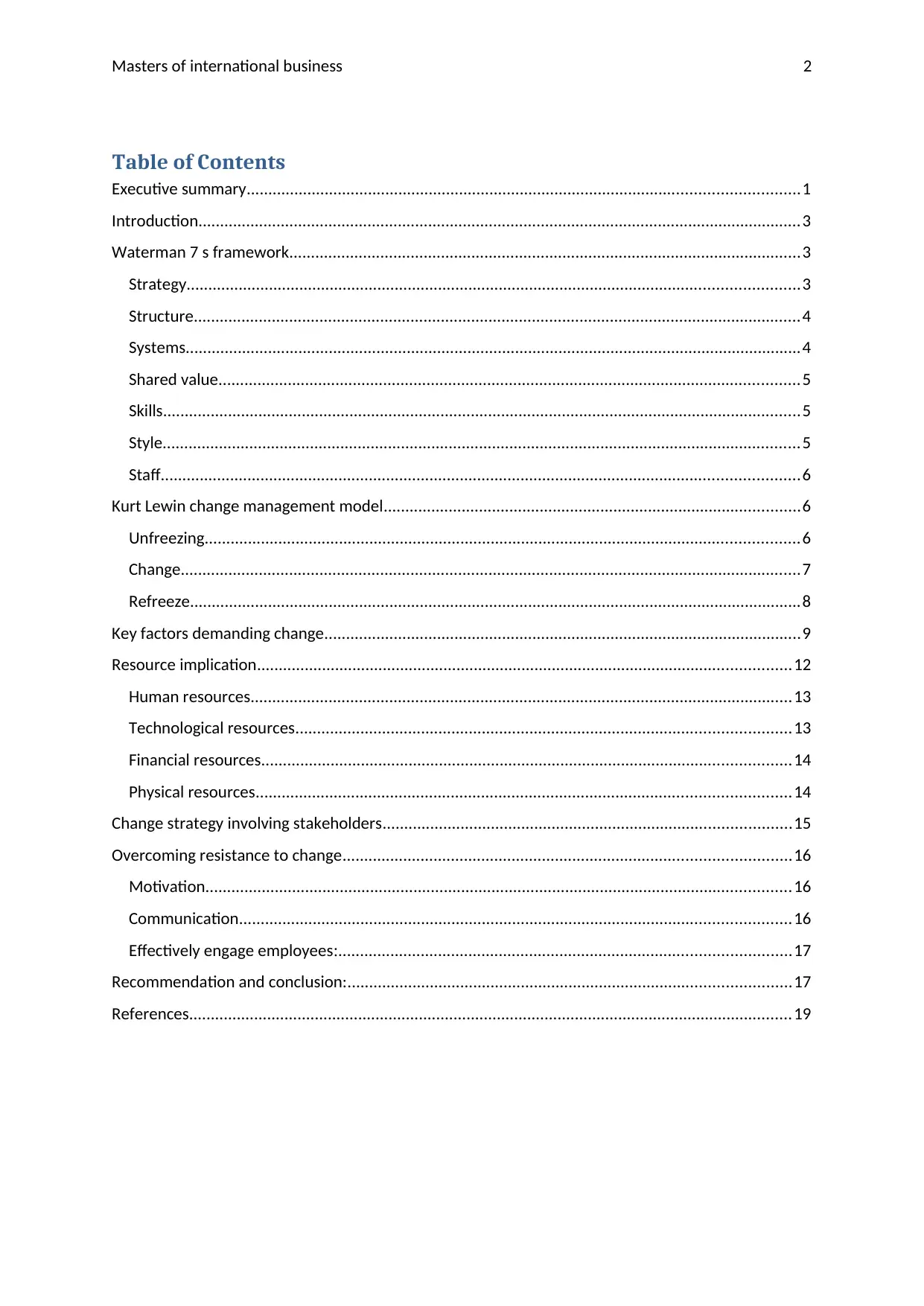
Masters of international business 2
Table of Contents
Executive summary...............................................................................................................................1
Introduction...........................................................................................................................................3
Waterman 7 s framework......................................................................................................................3
Strategy.............................................................................................................................................3
Structure............................................................................................................................................4
Systems..............................................................................................................................................4
Shared value......................................................................................................................................5
Skills...................................................................................................................................................5
Style...................................................................................................................................................5
Staff...................................................................................................................................................6
Kurt Lewin change management model................................................................................................6
Unfreezing.........................................................................................................................................6
Change...............................................................................................................................................7
Refreeze.............................................................................................................................................8
Key factors demanding change..............................................................................................................9
Resource implication...........................................................................................................................12
Human resources.............................................................................................................................13
Technological resources..................................................................................................................13
Financial resources..........................................................................................................................14
Physical resources...........................................................................................................................14
Change strategy involving stakeholders..............................................................................................15
Overcoming resistance to change.......................................................................................................16
Motivation.......................................................................................................................................16
Communication...............................................................................................................................16
Effectively engage employees:........................................................................................................17
Recommendation and conclusion:......................................................................................................17
References...........................................................................................................................................19
Table of Contents
Executive summary...............................................................................................................................1
Introduction...........................................................................................................................................3
Waterman 7 s framework......................................................................................................................3
Strategy.............................................................................................................................................3
Structure............................................................................................................................................4
Systems..............................................................................................................................................4
Shared value......................................................................................................................................5
Skills...................................................................................................................................................5
Style...................................................................................................................................................5
Staff...................................................................................................................................................6
Kurt Lewin change management model................................................................................................6
Unfreezing.........................................................................................................................................6
Change...............................................................................................................................................7
Refreeze.............................................................................................................................................8
Key factors demanding change..............................................................................................................9
Resource implication...........................................................................................................................12
Human resources.............................................................................................................................13
Technological resources..................................................................................................................13
Financial resources..........................................................................................................................14
Physical resources...........................................................................................................................14
Change strategy involving stakeholders..............................................................................................15
Overcoming resistance to change.......................................................................................................16
Motivation.......................................................................................................................................16
Communication...............................................................................................................................16
Effectively engage employees:........................................................................................................17
Recommendation and conclusion:......................................................................................................17
References...........................................................................................................................................19
⊘ This is a preview!⊘
Do you want full access?
Subscribe today to unlock all pages.

Trusted by 1+ million students worldwide
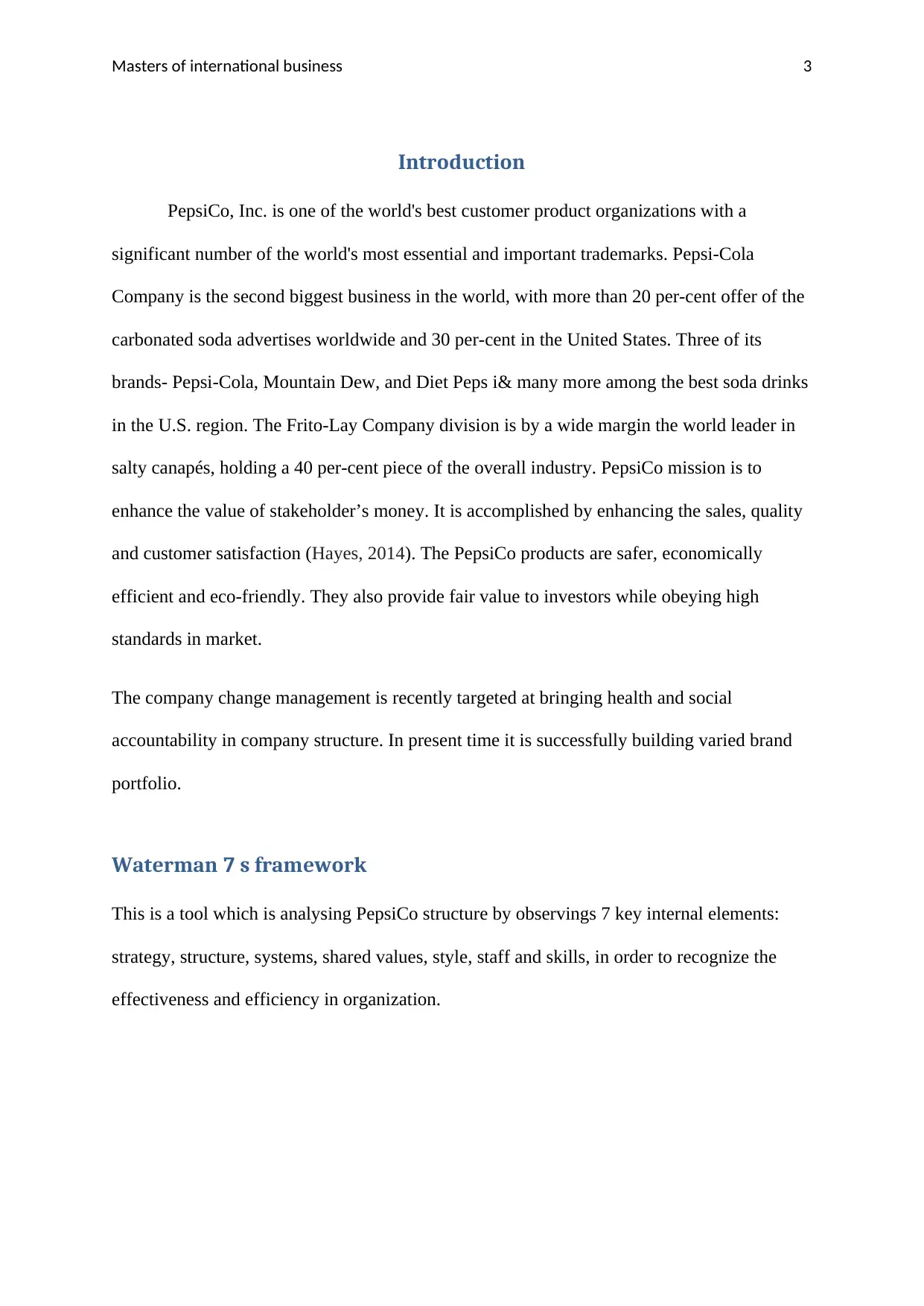
Masters of international business 3
Introduction
PepsiCo, Inc. is one of the world's best customer product organizations with a
significant number of the world's most essential and important trademarks. Pepsi-Cola
Company is the second biggest business in the world, with more than 20 per-cent offer of the
carbonated soda advertises worldwide and 30 per-cent in the United States. Three of its
brands- Pepsi-Cola, Mountain Dew, and Diet Peps i& many more among the best soda drinks
in the U.S. region. The Frito-Lay Company division is by a wide margin the world leader in
salty canapés, holding a 40 per-cent piece of the overall industry. PepsiCo mission is to
enhance the value of stakeholder’s money. It is accomplished by enhancing the sales, quality
and customer satisfaction (Hayes, 2014). The PepsiCo products are safer, economically
efficient and eco-friendly. They also provide fair value to investors while obeying high
standards in market.
The company change management is recently targeted at bringing health and social
accountability in company structure. In present time it is successfully building varied brand
portfolio.
Waterman 7 s framework
This is a tool which is analysing PepsiCo structure by observings 7 key internal elements:
strategy, structure, systems, shared values, style, staff and skills, in order to recognize the
effectiveness and efficiency in organization.
Introduction
PepsiCo, Inc. is one of the world's best customer product organizations with a
significant number of the world's most essential and important trademarks. Pepsi-Cola
Company is the second biggest business in the world, with more than 20 per-cent offer of the
carbonated soda advertises worldwide and 30 per-cent in the United States. Three of its
brands- Pepsi-Cola, Mountain Dew, and Diet Peps i& many more among the best soda drinks
in the U.S. region. The Frito-Lay Company division is by a wide margin the world leader in
salty canapés, holding a 40 per-cent piece of the overall industry. PepsiCo mission is to
enhance the value of stakeholder’s money. It is accomplished by enhancing the sales, quality
and customer satisfaction (Hayes, 2014). The PepsiCo products are safer, economically
efficient and eco-friendly. They also provide fair value to investors while obeying high
standards in market.
The company change management is recently targeted at bringing health and social
accountability in company structure. In present time it is successfully building varied brand
portfolio.
Waterman 7 s framework
This is a tool which is analysing PepsiCo structure by observings 7 key internal elements:
strategy, structure, systems, shared values, style, staff and skills, in order to recognize the
effectiveness and efficiency in organization.
Paraphrase This Document
Need a fresh take? Get an instant paraphrase of this document with our AI Paraphraser
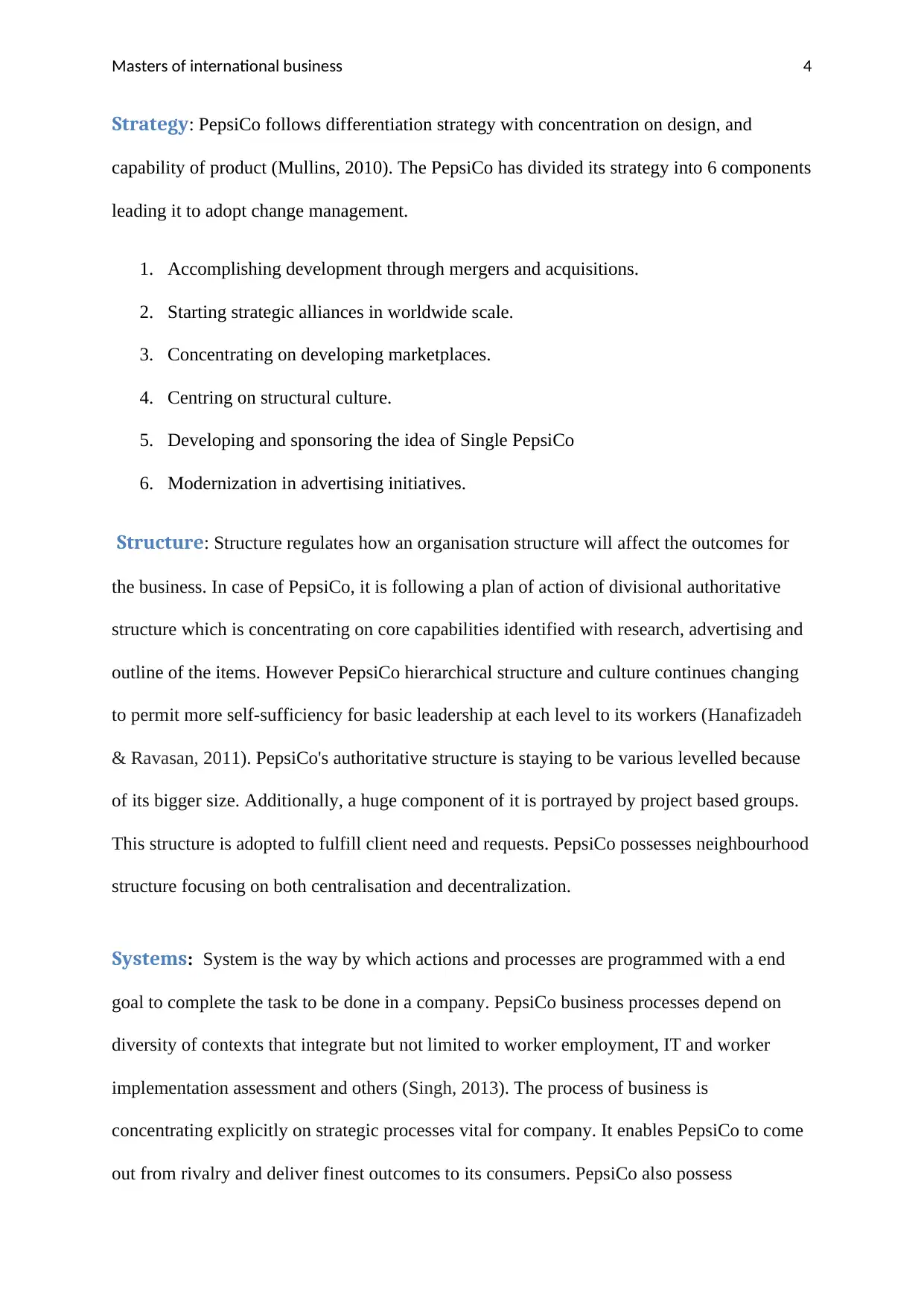
Masters of international business 4
Strategy: PepsiCo follows differentiation strategy with concentration on design, and
capability of product (Mullins, 2010). The PepsiCo has divided its strategy into 6 components
leading it to adopt change management.
1. Accomplishing development through mergers and acquisitions.
2. Starting strategic alliances in worldwide scale.
3. Concentrating on developing marketplaces.
4. Centring on structural culture.
5. Developing and sponsoring the idea of Single PepsiCo
6. Modernization in advertising initiatives.
Structure: Structure regulates how an organisation structure will affect the outcomes for
the business. In case of PepsiCo, it is following a plan of action of divisional authoritative
structure which is concentrating on core capabilities identified with research, advertising and
outline of the items. However PepsiCo hierarchical structure and culture continues changing
to permit more self-sufficiency for basic leadership at each level to its workers (Hanafizadeh
& Ravasan, 2011). PepsiCo's authoritative structure is staying to be various levelled because
of its bigger size. Additionally, a huge component of it is portrayed by project based groups.
This structure is adopted to fulfill client need and requests. PepsiCo possesses neighbourhood
structure focusing on both centralisation and decentralization.
Systems: System is the way by which actions and processes are programmed with a end
goal to complete the task to be done in a company. PepsiCo business processes depend on
diversity of contexts that integrate but not limited to worker employment, IT and worker
implementation assessment and others (Singh, 2013). The process of business is
concentrating explicitly on strategic processes vital for company. It enables PepsiCo to come
out from rivalry and deliver finest outcomes to its consumers. PepsiCo also possess
Strategy: PepsiCo follows differentiation strategy with concentration on design, and
capability of product (Mullins, 2010). The PepsiCo has divided its strategy into 6 components
leading it to adopt change management.
1. Accomplishing development through mergers and acquisitions.
2. Starting strategic alliances in worldwide scale.
3. Concentrating on developing marketplaces.
4. Centring on structural culture.
5. Developing and sponsoring the idea of Single PepsiCo
6. Modernization in advertising initiatives.
Structure: Structure regulates how an organisation structure will affect the outcomes for
the business. In case of PepsiCo, it is following a plan of action of divisional authoritative
structure which is concentrating on core capabilities identified with research, advertising and
outline of the items. However PepsiCo hierarchical structure and culture continues changing
to permit more self-sufficiency for basic leadership at each level to its workers (Hanafizadeh
& Ravasan, 2011). PepsiCo's authoritative structure is staying to be various levelled because
of its bigger size. Additionally, a huge component of it is portrayed by project based groups.
This structure is adopted to fulfill client need and requests. PepsiCo possesses neighbourhood
structure focusing on both centralisation and decentralization.
Systems: System is the way by which actions and processes are programmed with a end
goal to complete the task to be done in a company. PepsiCo business processes depend on
diversity of contexts that integrate but not limited to worker employment, IT and worker
implementation assessment and others (Singh, 2013). The process of business is
concentrating explicitly on strategic processes vital for company. It enables PepsiCo to come
out from rivalry and deliver finest outcomes to its consumers. PepsiCo also possess
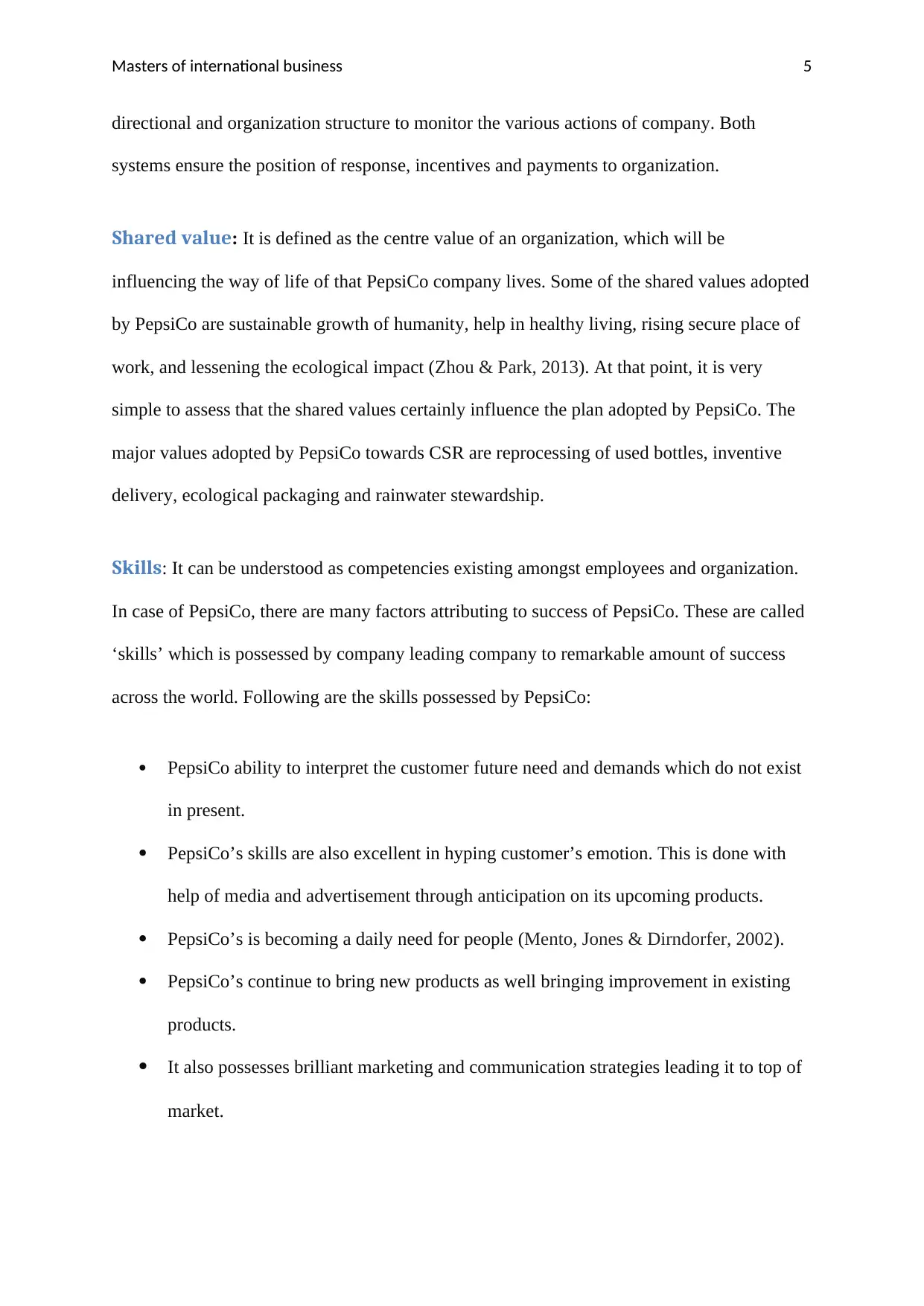
Masters of international business 5
directional and organization structure to monitor the various actions of company. Both
systems ensure the position of response, incentives and payments to organization.
Shared value: It is defined as the centre value of an organization, which will be
influencing the way of life of that PepsiCo company lives. Some of the shared values adopted
by PepsiCo are sustainable growth of humanity, help in healthy living, rising secure place of
work, and lessening the ecological impact (Zhou & Park, 2013). At that point, it is very
simple to assess that the shared values certainly influence the plan adopted by PepsiCo. The
major values adopted by PepsiCo towards CSR are reprocessing of used bottles, inventive
delivery, ecological packaging and rainwater stewardship.
Skills: It can be understood as competencies existing amongst employees and organization.
In case of PepsiCo, there are many factors attributing to success of PepsiCo. These are called
‘skills’ which is possessed by company leading company to remarkable amount of success
across the world. Following are the skills possessed by PepsiCo:
PepsiCo ability to interpret the customer future need and demands which do not exist
in present.
PepsiCo’s skills are also excellent in hyping customer’s emotion. This is done with
help of media and advertisement through anticipation on its upcoming products.
PepsiCo’s is becoming a daily need for people (Mento, Jones & Dirndorfer, 2002).
PepsiCo’s continue to bring new products as well bringing improvement in existing
products.
It also possesses brilliant marketing and communication strategies leading it to top of
market.
directional and organization structure to monitor the various actions of company. Both
systems ensure the position of response, incentives and payments to organization.
Shared value: It is defined as the centre value of an organization, which will be
influencing the way of life of that PepsiCo company lives. Some of the shared values adopted
by PepsiCo are sustainable growth of humanity, help in healthy living, rising secure place of
work, and lessening the ecological impact (Zhou & Park, 2013). At that point, it is very
simple to assess that the shared values certainly influence the plan adopted by PepsiCo. The
major values adopted by PepsiCo towards CSR are reprocessing of used bottles, inventive
delivery, ecological packaging and rainwater stewardship.
Skills: It can be understood as competencies existing amongst employees and organization.
In case of PepsiCo, there are many factors attributing to success of PepsiCo. These are called
‘skills’ which is possessed by company leading company to remarkable amount of success
across the world. Following are the skills possessed by PepsiCo:
PepsiCo ability to interpret the customer future need and demands which do not exist
in present.
PepsiCo’s skills are also excellent in hyping customer’s emotion. This is done with
help of media and advertisement through anticipation on its upcoming products.
PepsiCo’s is becoming a daily need for people (Mento, Jones & Dirndorfer, 2002).
PepsiCo’s continue to bring new products as well bringing improvement in existing
products.
It also possesses brilliant marketing and communication strategies leading it to top of
market.
⊘ This is a preview!⊘
Do you want full access?
Subscribe today to unlock all pages.

Trusted by 1+ million students worldwide
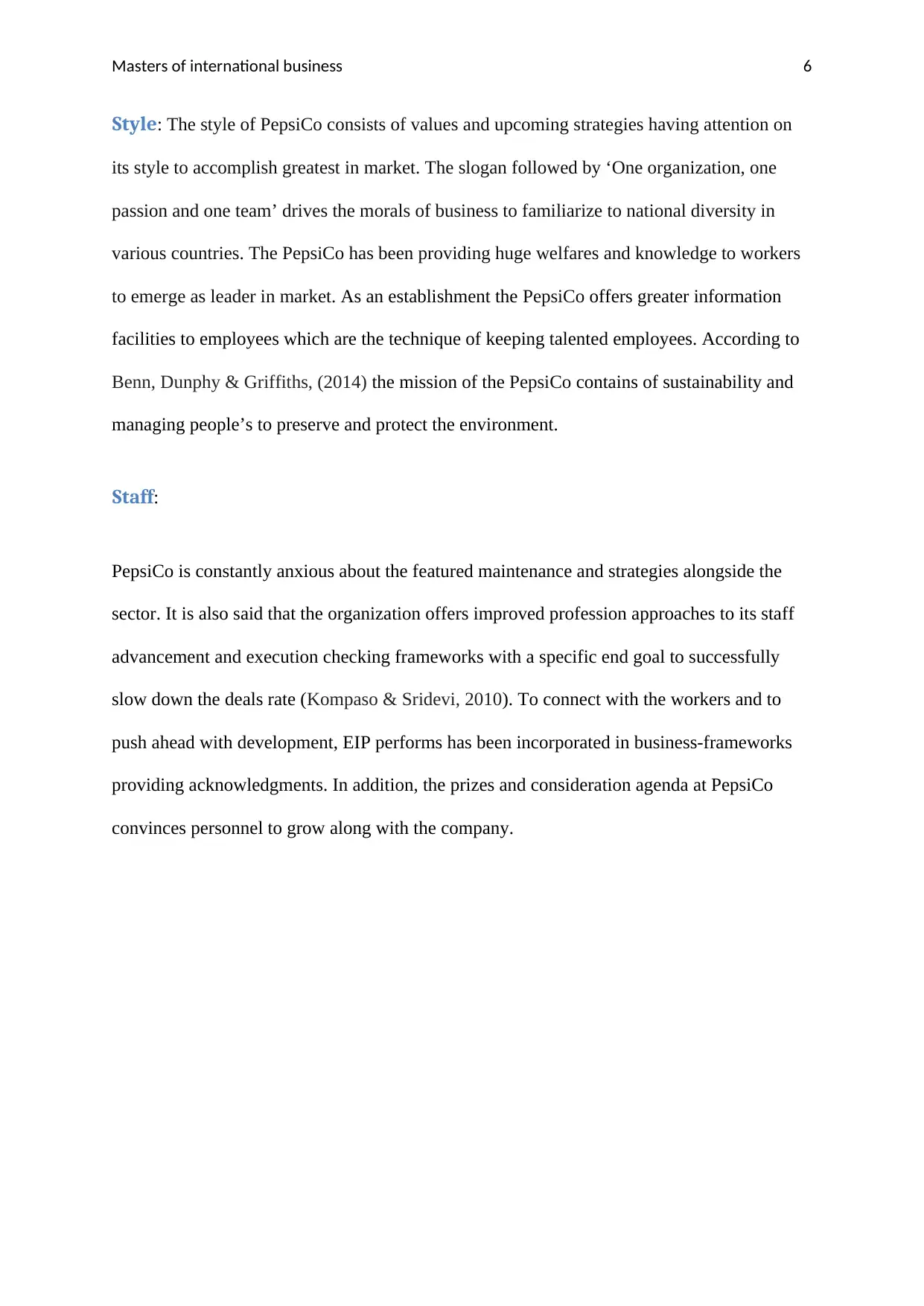
Masters of international business 6
Style: The style of PepsiCo consists of values and upcoming strategies having attention on
its style to accomplish greatest in market. The slogan followed by ‘One organization, one
passion and one team’ drives the morals of business to familiarize to national diversity in
various countries. The PepsiCo has been providing huge welfares and knowledge to workers
to emerge as leader in market. As an establishment the PepsiCo offers greater information
facilities to employees which are the technique of keeping talented employees. According to
Benn, Dunphy & Griffiths, (2014) the mission of the PepsiCo contains of sustainability and
managing people’s to preserve and protect the environment.
Staff:
PepsiCo is constantly anxious about the featured maintenance and strategies alongside the
sector. It is also said that the organization offers improved profession approaches to its staff
advancement and execution checking frameworks with a specific end goal to successfully
slow down the deals rate (Kompaso & Sridevi, 2010). To connect with the workers and to
push ahead with development, EIP performs has been incorporated in business-frameworks
providing acknowledgments. In addition, the prizes and consideration agenda at PepsiCo
convinces personnel to grow along with the company.
Style: The style of PepsiCo consists of values and upcoming strategies having attention on
its style to accomplish greatest in market. The slogan followed by ‘One organization, one
passion and one team’ drives the morals of business to familiarize to national diversity in
various countries. The PepsiCo has been providing huge welfares and knowledge to workers
to emerge as leader in market. As an establishment the PepsiCo offers greater information
facilities to employees which are the technique of keeping talented employees. According to
Benn, Dunphy & Griffiths, (2014) the mission of the PepsiCo contains of sustainability and
managing people’s to preserve and protect the environment.
Staff:
PepsiCo is constantly anxious about the featured maintenance and strategies alongside the
sector. It is also said that the organization offers improved profession approaches to its staff
advancement and execution checking frameworks with a specific end goal to successfully
slow down the deals rate (Kompaso & Sridevi, 2010). To connect with the workers and to
push ahead with development, EIP performs has been incorporated in business-frameworks
providing acknowledgments. In addition, the prizes and consideration agenda at PepsiCo
convinces personnel to grow along with the company.
Paraphrase This Document
Need a fresh take? Get an instant paraphrase of this document with our AI Paraphraser
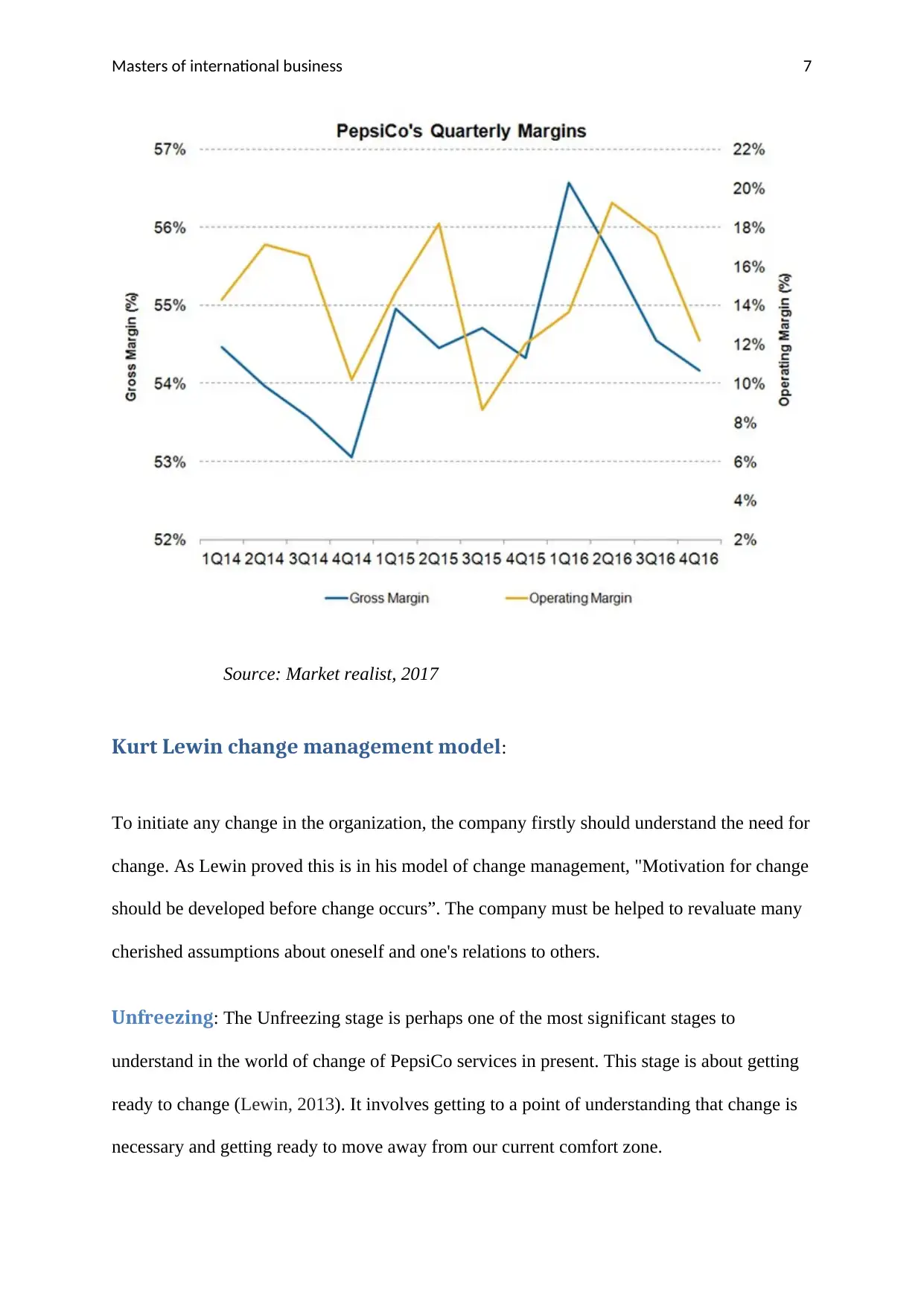
Masters of international business 7
Source: Market realist, 2017
Kurt Lewin change management model:
To initiate any change in the organization, the company firstly should understand the need for
change. As Lewin proved this is in his model of change management, "Motivation for change
should be developed before change occurs”. The company must be helped to revaluate many
cherished assumptions about oneself and one's relations to others.
Unfreezing: The Unfreezing stage is perhaps one of the most significant stages to
understand in the world of change of PepsiCo services in present. This stage is about getting
ready to change (Lewin, 2013). It involves getting to a point of understanding that change is
necessary and getting ready to move away from our current comfort zone.
Source: Market realist, 2017
Kurt Lewin change management model:
To initiate any change in the organization, the company firstly should understand the need for
change. As Lewin proved this is in his model of change management, "Motivation for change
should be developed before change occurs”. The company must be helped to revaluate many
cherished assumptions about oneself and one's relations to others.
Unfreezing: The Unfreezing stage is perhaps one of the most significant stages to
understand in the world of change of PepsiCo services in present. This stage is about getting
ready to change (Lewin, 2013). It involves getting to a point of understanding that change is
necessary and getting ready to move away from our current comfort zone.
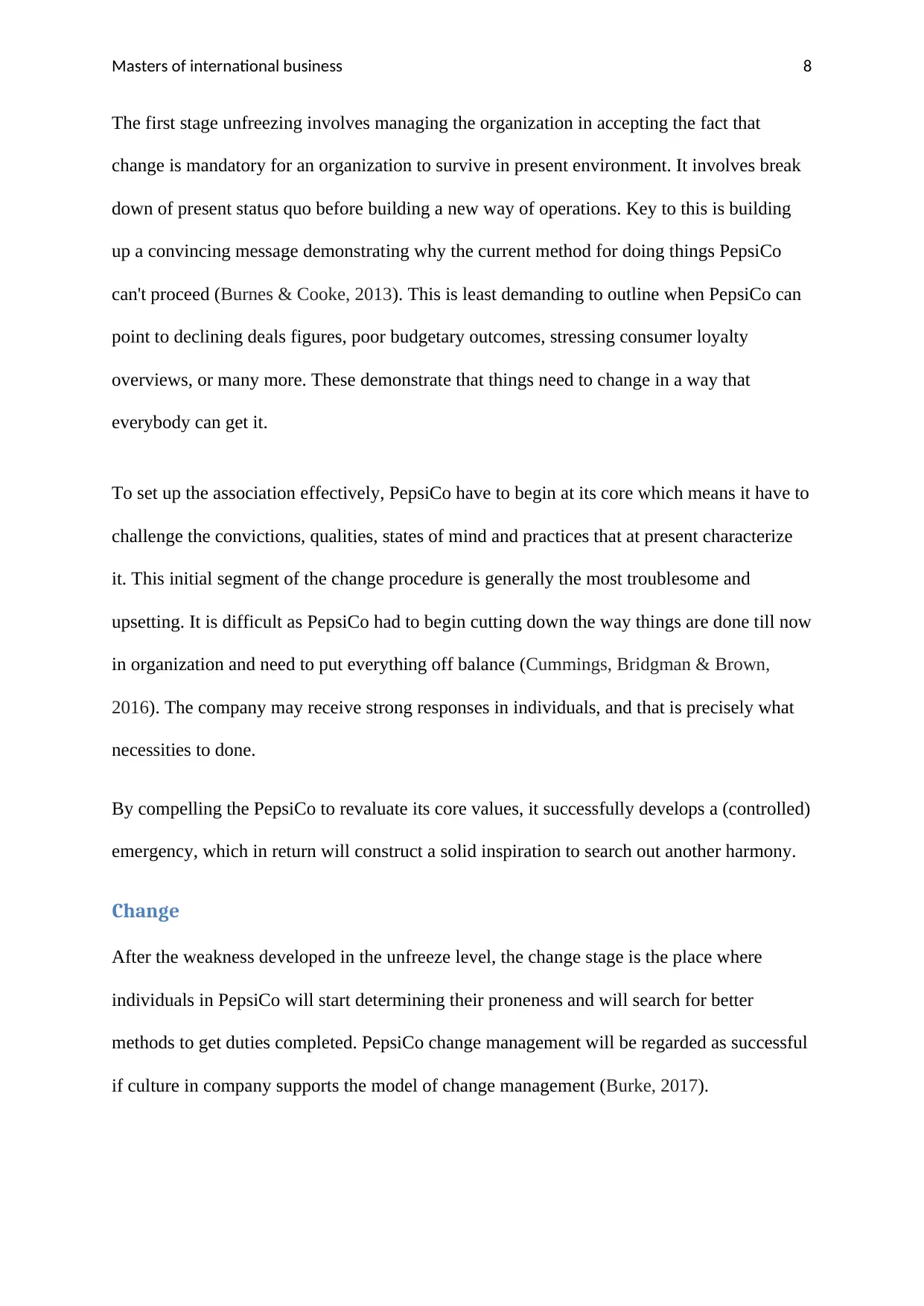
Masters of international business 8
The first stage unfreezing involves managing the organization in accepting the fact that
change is mandatory for an organization to survive in present environment. It involves break
down of present status quo before building a new way of operations. Key to this is building
up a convincing message demonstrating why the current method for doing things PepsiCo
can't proceed (Burnes & Cooke, 2013). This is least demanding to outline when PepsiCo can
point to declining deals figures, poor budgetary outcomes, stressing consumer loyalty
overviews, or many more. These demonstrate that things need to change in a way that
everybody can get it.
To set up the association effectively, PepsiCo have to begin at its core which means it have to
challenge the convictions, qualities, states of mind and practices that at present characterize
it. This initial segment of the change procedure is generally the most troublesome and
upsetting. It is difficult as PepsiCo had to begin cutting down the way things are done till now
in organization and need to put everything off balance (Cummings, Bridgman & Brown,
2016). The company may receive strong responses in individuals, and that is precisely what
necessities to done.
By compelling the PepsiCo to revaluate its core values, it successfully develops a (controlled)
emergency, which in return will construct a solid inspiration to search out another harmony.
Change
After the weakness developed in the unfreeze level, the change stage is the place where
individuals in PepsiCo will start determining their proneness and will search for better
methods to get duties completed. PepsiCo change management will be regarded as successful
if culture in company supports the model of change management (Burke, 2017).
The first stage unfreezing involves managing the organization in accepting the fact that
change is mandatory for an organization to survive in present environment. It involves break
down of present status quo before building a new way of operations. Key to this is building
up a convincing message demonstrating why the current method for doing things PepsiCo
can't proceed (Burnes & Cooke, 2013). This is least demanding to outline when PepsiCo can
point to declining deals figures, poor budgetary outcomes, stressing consumer loyalty
overviews, or many more. These demonstrate that things need to change in a way that
everybody can get it.
To set up the association effectively, PepsiCo have to begin at its core which means it have to
challenge the convictions, qualities, states of mind and practices that at present characterize
it. This initial segment of the change procedure is generally the most troublesome and
upsetting. It is difficult as PepsiCo had to begin cutting down the way things are done till now
in organization and need to put everything off balance (Cummings, Bridgman & Brown,
2016). The company may receive strong responses in individuals, and that is precisely what
necessities to done.
By compelling the PepsiCo to revaluate its core values, it successfully develops a (controlled)
emergency, which in return will construct a solid inspiration to search out another harmony.
Change
After the weakness developed in the unfreeze level, the change stage is the place where
individuals in PepsiCo will start determining their proneness and will search for better
methods to get duties completed. PepsiCo change management will be regarded as successful
if culture in company supports the model of change management (Burke, 2017).
⊘ This is a preview!⊘
Do you want full access?
Subscribe today to unlock all pages.

Trusted by 1+ million students worldwide
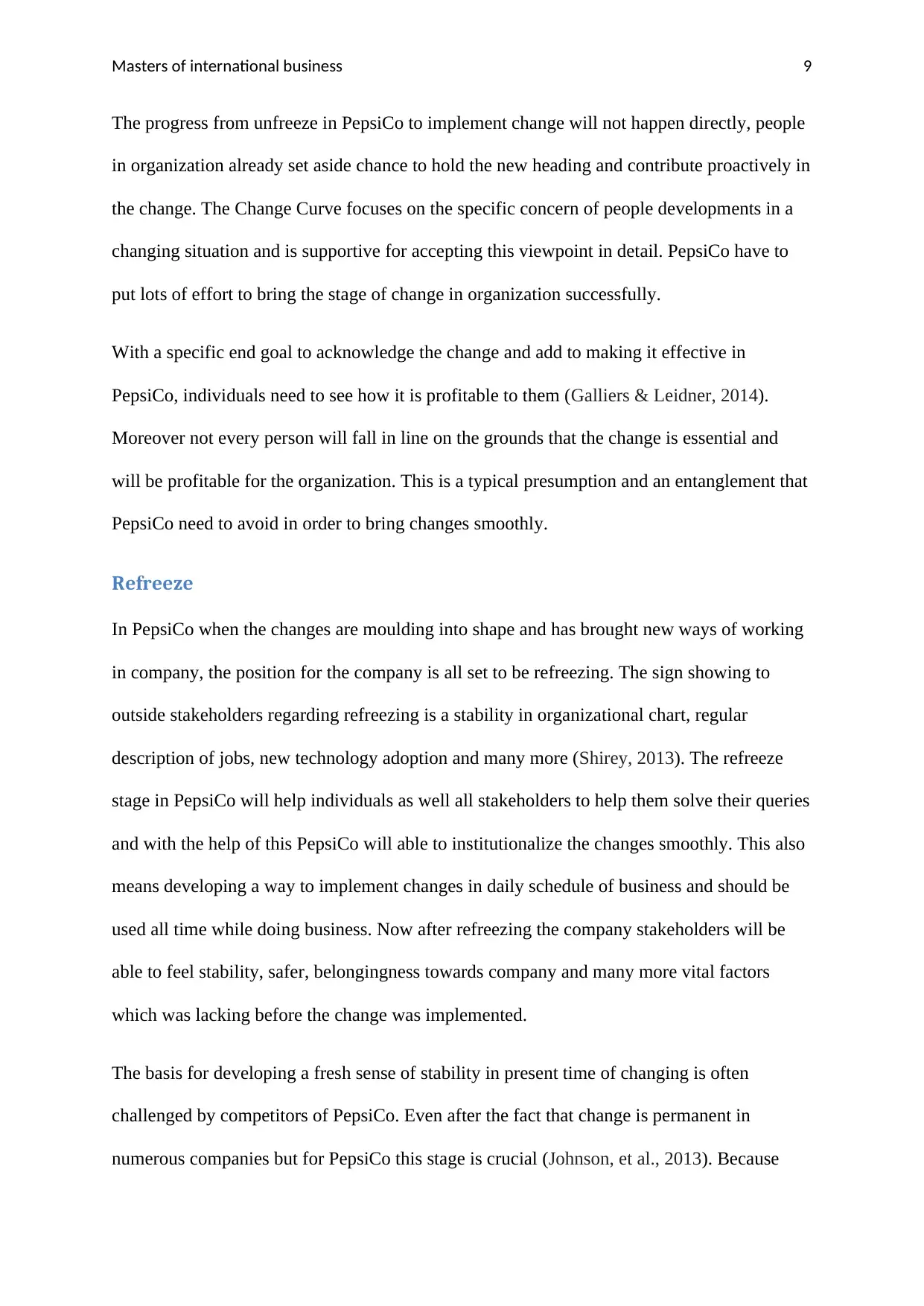
Masters of international business 9
The progress from unfreeze in PepsiCo to implement change will not happen directly, people
in organization already set aside chance to hold the new heading and contribute proactively in
the change. The Change Curve focuses on the specific concern of people developments in a
changing situation and is supportive for accepting this viewpoint in detail. PepsiCo have to
put lots of effort to bring the stage of change in organization successfully.
With a specific end goal to acknowledge the change and add to making it effective in
PepsiCo, individuals need to see how it is profitable to them (Galliers & Leidner, 2014).
Moreover not every person will fall in line on the grounds that the change is essential and
will be profitable for the organization. This is a typical presumption and an entanglement that
PepsiCo need to avoid in order to bring changes smoothly.
Refreeze
In PepsiCo when the changes are moulding into shape and has brought new ways of working
in company, the position for the company is all set to be refreezing. The sign showing to
outside stakeholders regarding refreezing is a stability in organizational chart, regular
description of jobs, new technology adoption and many more (Shirey, 2013). The refreeze
stage in PepsiCo will help individuals as well all stakeholders to help them solve their queries
and with the help of this PepsiCo will able to institutionalize the changes smoothly. This also
means developing a way to implement changes in daily schedule of business and should be
used all time while doing business. Now after refreezing the company stakeholders will be
able to feel stability, safer, belongingness towards company and many more vital factors
which was lacking before the change was implemented.
The basis for developing a fresh sense of stability in present time of changing is often
challenged by competitors of PepsiCo. Even after the fact that change is permanent in
numerous companies but for PepsiCo this stage is crucial (Johnson, et al., 2013). Because
The progress from unfreeze in PepsiCo to implement change will not happen directly, people
in organization already set aside chance to hold the new heading and contribute proactively in
the change. The Change Curve focuses on the specific concern of people developments in a
changing situation and is supportive for accepting this viewpoint in detail. PepsiCo have to
put lots of effort to bring the stage of change in organization successfully.
With a specific end goal to acknowledge the change and add to making it effective in
PepsiCo, individuals need to see how it is profitable to them (Galliers & Leidner, 2014).
Moreover not every person will fall in line on the grounds that the change is essential and
will be profitable for the organization. This is a typical presumption and an entanglement that
PepsiCo need to avoid in order to bring changes smoothly.
Refreeze
In PepsiCo when the changes are moulding into shape and has brought new ways of working
in company, the position for the company is all set to be refreezing. The sign showing to
outside stakeholders regarding refreezing is a stability in organizational chart, regular
description of jobs, new technology adoption and many more (Shirey, 2013). The refreeze
stage in PepsiCo will help individuals as well all stakeholders to help them solve their queries
and with the help of this PepsiCo will able to institutionalize the changes smoothly. This also
means developing a way to implement changes in daily schedule of business and should be
used all time while doing business. Now after refreezing the company stakeholders will be
able to feel stability, safer, belongingness towards company and many more vital factors
which was lacking before the change was implemented.
The basis for developing a fresh sense of stability in present time of changing is often
challenged by competitors of PepsiCo. Even after the fact that change is permanent in
numerous companies but for PepsiCo this stage is crucial (Johnson, et al., 2013). Because
Paraphrase This Document
Need a fresh take? Get an instant paraphrase of this document with our AI Paraphraser
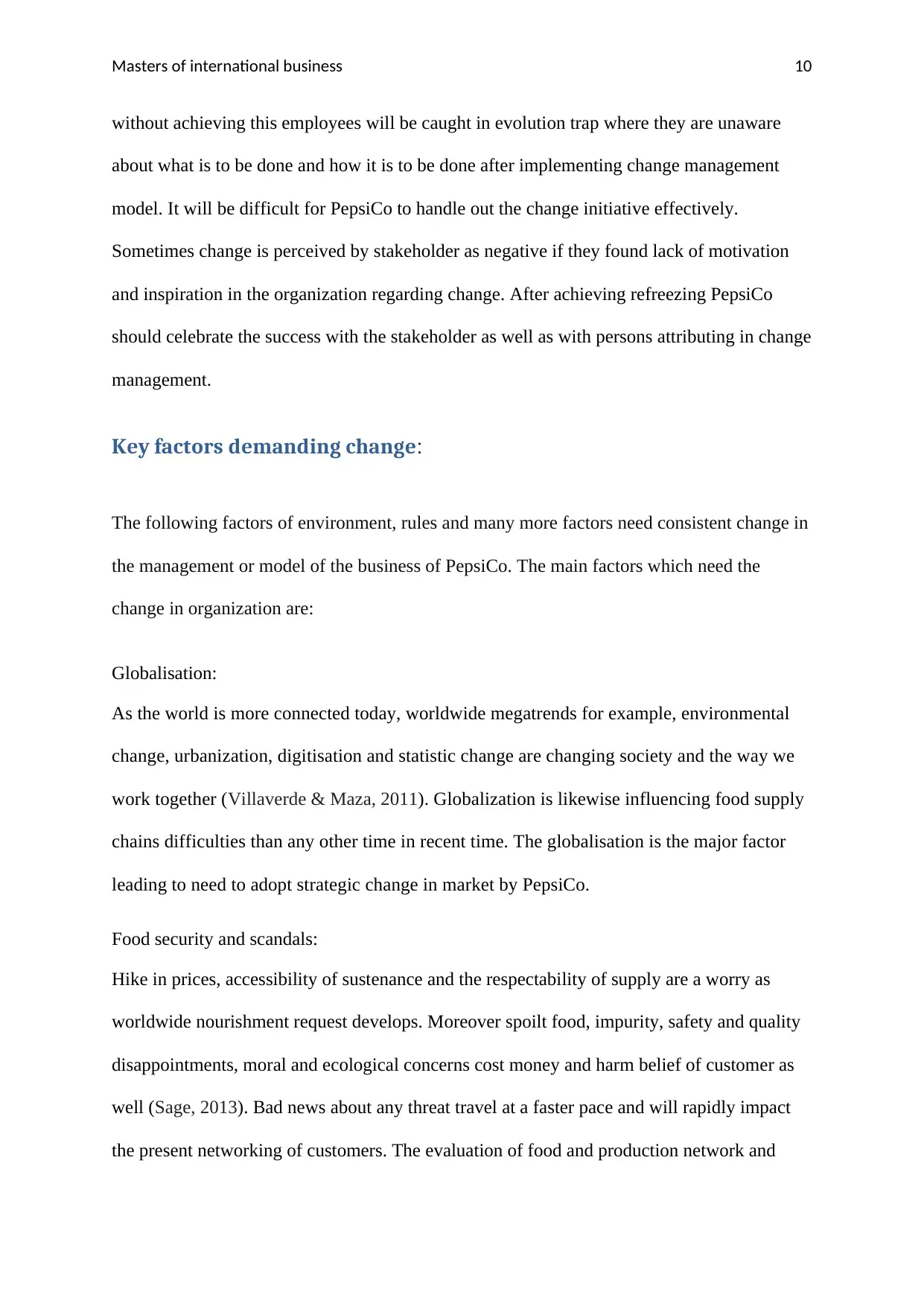
Masters of international business 10
without achieving this employees will be caught in evolution trap where they are unaware
about what is to be done and how it is to be done after implementing change management
model. It will be difficult for PepsiCo to handle out the change initiative effectively.
Sometimes change is perceived by stakeholder as negative if they found lack of motivation
and inspiration in the organization regarding change. After achieving refreezing PepsiCo
should celebrate the success with the stakeholder as well as with persons attributing in change
management.
Key factors demanding change:
The following factors of environment, rules and many more factors need consistent change in
the management or model of the business of PepsiCo. The main factors which need the
change in organization are:
Globalisation:
As the world is more connected today, worldwide megatrends for example, environmental
change, urbanization, digitisation and statistic change are changing society and the way we
work together (Villaverde & Maza, 2011). Globalization is likewise influencing food supply
chains difficulties than any other time in recent time. The globalisation is the major factor
leading to need to adopt strategic change in market by PepsiCo.
Food security and scandals:
Hike in prices, accessibility of sustenance and the respectability of supply are a worry as
worldwide nourishment request develops. Moreover spoilt food, impurity, safety and quality
disappointments, moral and ecological concerns cost money and harm belief of customer as
well (Sage, 2013). Bad news about any threat travel at a faster pace and will rapidly impact
the present networking of customers. The evaluation of food and production network and
without achieving this employees will be caught in evolution trap where they are unaware
about what is to be done and how it is to be done after implementing change management
model. It will be difficult for PepsiCo to handle out the change initiative effectively.
Sometimes change is perceived by stakeholder as negative if they found lack of motivation
and inspiration in the organization regarding change. After achieving refreezing PepsiCo
should celebrate the success with the stakeholder as well as with persons attributing in change
management.
Key factors demanding change:
The following factors of environment, rules and many more factors need consistent change in
the management or model of the business of PepsiCo. The main factors which need the
change in organization are:
Globalisation:
As the world is more connected today, worldwide megatrends for example, environmental
change, urbanization, digitisation and statistic change are changing society and the way we
work together (Villaverde & Maza, 2011). Globalization is likewise influencing food supply
chains difficulties than any other time in recent time. The globalisation is the major factor
leading to need to adopt strategic change in market by PepsiCo.
Food security and scandals:
Hike in prices, accessibility of sustenance and the respectability of supply are a worry as
worldwide nourishment request develops. Moreover spoilt food, impurity, safety and quality
disappointments, moral and ecological concerns cost money and harm belief of customer as
well (Sage, 2013). Bad news about any threat travel at a faster pace and will rapidly impact
the present networking of customers. The evaluation of food and production network and
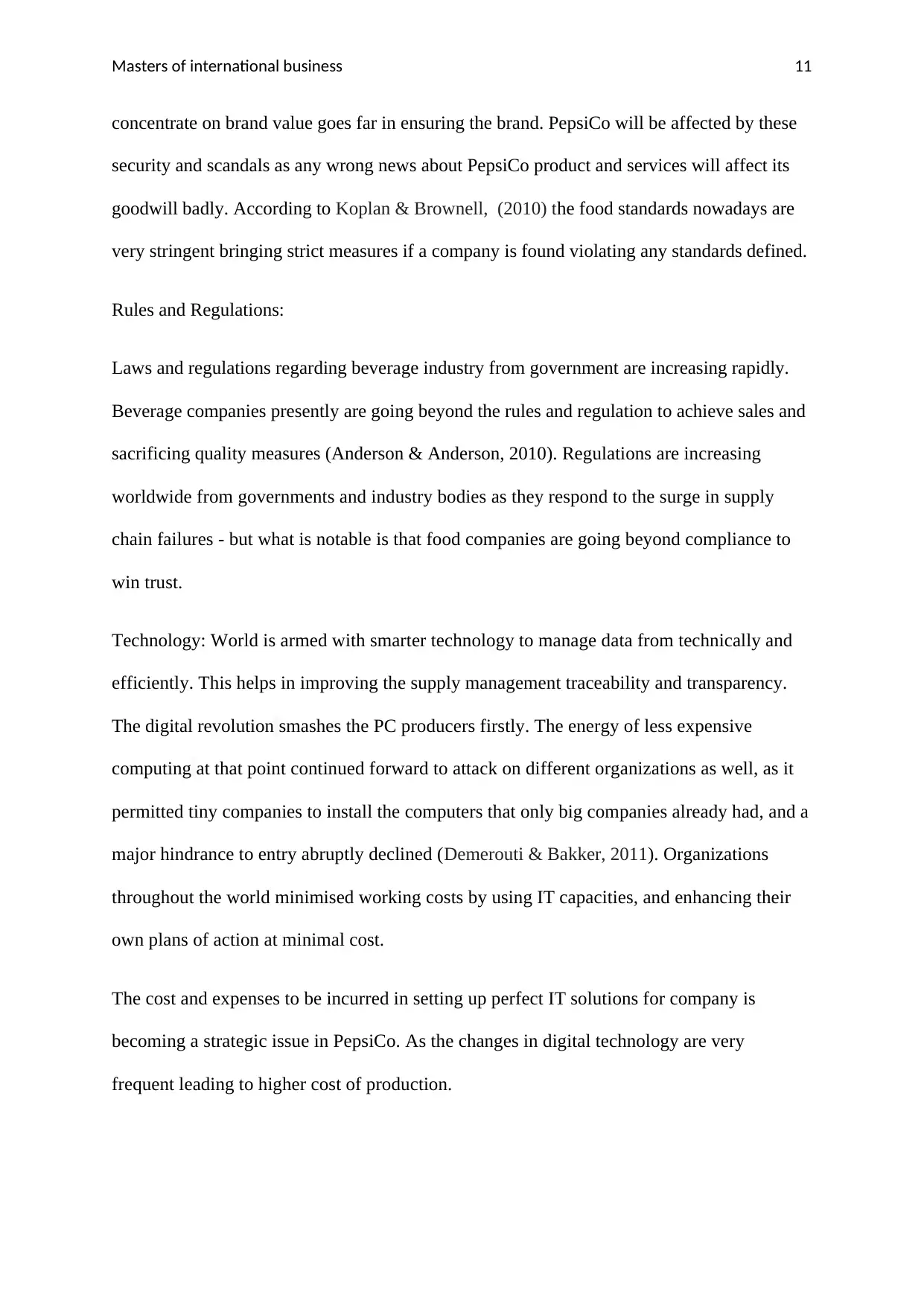
Masters of international business 11
concentrate on brand value goes far in ensuring the brand. PepsiCo will be affected by these
security and scandals as any wrong news about PepsiCo product and services will affect its
goodwill badly. According to Koplan & Brownell, (2010) the food standards nowadays are
very stringent bringing strict measures if a company is found violating any standards defined.
Rules and Regulations:
Laws and regulations regarding beverage industry from government are increasing rapidly.
Beverage companies presently are going beyond the rules and regulation to achieve sales and
sacrificing quality measures (Anderson & Anderson, 2010). Regulations are increasing
worldwide from governments and industry bodies as they respond to the surge in supply
chain failures - but what is notable is that food companies are going beyond compliance to
win trust.
Technology: World is armed with smarter technology to manage data from technically and
efficiently. This helps in improving the supply management traceability and transparency.
The digital revolution smashes the PC producers firstly. The energy of less expensive
computing at that point continued forward to attack on different organizations as well, as it
permitted tiny companies to install the computers that only big companies already had, and a
major hindrance to entry abruptly declined (Demerouti & Bakker, 2011). Organizations
throughout the world minimised working costs by using IT capacities, and enhancing their
own plans of action at minimal cost.
The cost and expenses to be incurred in setting up perfect IT solutions for company is
becoming a strategic issue in PepsiCo. As the changes in digital technology are very
frequent leading to higher cost of production.
concentrate on brand value goes far in ensuring the brand. PepsiCo will be affected by these
security and scandals as any wrong news about PepsiCo product and services will affect its
goodwill badly. According to Koplan & Brownell, (2010) the food standards nowadays are
very stringent bringing strict measures if a company is found violating any standards defined.
Rules and Regulations:
Laws and regulations regarding beverage industry from government are increasing rapidly.
Beverage companies presently are going beyond the rules and regulation to achieve sales and
sacrificing quality measures (Anderson & Anderson, 2010). Regulations are increasing
worldwide from governments and industry bodies as they respond to the surge in supply
chain failures - but what is notable is that food companies are going beyond compliance to
win trust.
Technology: World is armed with smarter technology to manage data from technically and
efficiently. This helps in improving the supply management traceability and transparency.
The digital revolution smashes the PC producers firstly. The energy of less expensive
computing at that point continued forward to attack on different organizations as well, as it
permitted tiny companies to install the computers that only big companies already had, and a
major hindrance to entry abruptly declined (Demerouti & Bakker, 2011). Organizations
throughout the world minimised working costs by using IT capacities, and enhancing their
own plans of action at minimal cost.
The cost and expenses to be incurred in setting up perfect IT solutions for company is
becoming a strategic issue in PepsiCo. As the changes in digital technology are very
frequent leading to higher cost of production.
⊘ This is a preview!⊘
Do you want full access?
Subscribe today to unlock all pages.

Trusted by 1+ million students worldwide
1 out of 23
Related Documents
Your All-in-One AI-Powered Toolkit for Academic Success.
+13062052269
info@desklib.com
Available 24*7 on WhatsApp / Email
![[object Object]](/_next/static/media/star-bottom.7253800d.svg)
Unlock your academic potential
Copyright © 2020–2025 A2Z Services. All Rights Reserved. Developed and managed by ZUCOL.




